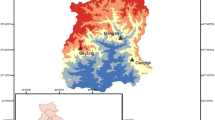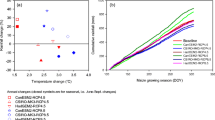Abstract
Due to heavy dependence on rain-fed agriculture, most developing countries, particularly Sub-Saharan Africa including Tanzania, are likely to suffer negatively to the impacts of climate change. Future climate projections predict a 2–4 °C rise in temperature by 2100, and rainfall is expected to decrease especially in the interior regions. As a result, grain production is predicted to decrease, and particularly maize, which is the main cereal crop, will experience up to 33 % decrease in yield. To capture the impacts of climate change relevant to agronomic productivity, site-specific assessments are needed to inform adaptation options. This study investigated the impacts of climate change on maize production using outputs of Global Circulation Models (GCMs) and crop simulation models. Current conventional and recommended agronomic practices in Same District, Kilimanjaro region, Tanzania were simulated by Agricultural Production Systems sIMulator (APSIM) model using long-term and projected future climates. Four maize cultivars commonly used in the study area Situka, Kito, Sc401, and TMV1 were used. Results show a yield decline of 13 % for cultivar Situka, and an increase of 10 % and 15 % for cultivars Sc401 and TMV1, respectively, in the long rainy season (March-May) under the conventional practices. A yield increase of 10 % is projected for Sc401 and TMV1 and a decrease of 10 % for Situka and 45 % for Kito cultivars under recommended practices. The short rainy season (October–December) is projected to register yield increases of between 75 and 146 % for all cultivars under both conventional and recommended agronomic practices. Generally, the study has revealed that the yield of only some maize varieties are expected to decrease due to a 2 °C rise in temperature and only during the long rainy season. Therefore, there is a need for more site-specific climate change studies that evaluate several crop varieties grown in the area.
Access this chapter
Tax calculation will be finalised at checkout
Purchases are for personal use only
Similar content being viewed by others
Abbreviations
- APSIM:
-
Agricultural Production Systems sIMulator
- CGCM:
-
Canadian Centre for Climate Modelling and Analysis
- CNRM:
-
Centre National de Recherches Météorologiques
- DSSAT:
-
Decision support system for agrotechnology transfer
- DUL:
-
Dry upper limit
- ENSO:
-
El Nino – southern oscillation
- GCMs:
-
Global circulation models
- IPSL:
-
Institut Pierre Simon Laplace
- LL:
-
Lower limit
- MAM:
-
March-April-May season
- OND:
-
October-November-December season
- SOM:
-
Self-organizing map
- SSA:
-
Sub-Saharan Africa
- TOSCA:
-
Tanzania Official Seed Certification Agency
References
Adger WN, Huq S, Brown K, Conway D, Hulme M (2003) Adaptation to climate change in the developing world. Prog Dev Stud 3:179–195
Bradshaw B, Dolan H, Smit B (2004) Farm-level adaptation to climatic variability and change: crop diversification in the Canadian Prairies. Clim Change 67:119–141
Cooper PJM, Dimes J, Rao KPC, Shapiro B, Shiferaw B, Twomlow S (2008) Coping better with current climatic variability in the rain-fed farming systems of sub-Saharan Africa: an essential first step in adapting to future climate change? Agric Ecosyst Environ 126:24–35
Cubasch U, Wuebbles D, Chen D, Facchini MC, Frame D, Mahowald N, Winther JG (2013) Introduction. In: Stocker TF, Qin D, Plattner GK, Tignor M, Allen SK, Boschung J, Nauels A, Xia Y, Bex V, Midgley PM (eds) Climate change 2013: the physical science basis. Contribution of Working Group I to the fifth assessment report of the Intergovernmental Panel on Climate Change. Cambridge University Press, Cambridge/New York
Deressa TT, Hassan RM, Ringler C, Alemu T, Yesuf M (2009) Determinants of farmers’ choice of adaptation methods to climate change in the Nile Basin of Ethiopia. Glob Environ Change 19:248–255
Devereux S, Edwards J (2004) Climate change and food security. IDS Bull 35:22–30
Enfors E, Gordon L (2007) Analyzing resilience in dryland agro-ecosystems. A case study of the Makanya catchment in Tanzania over the past 50 years. Land Degrad Dev 18:680–696
Enfors EI, Gordon LJ (2008) Dealing with drought: the challenge of using water system technologies to break dryland poverty traps. Glob Environ Change 18:607–616
Feenstra JF, Burton I, Smith JB, Tol RSJ (1998) Handbook on methods for climate change impact assessment and adaptation strategies. UNEP/Vrije Universiteit, Amsterdam
Griggs DJ, Noguer M (2002) Climate change 2001: the scientific basis. Contribution of Working Group I to the third assessment report of the Intergovernmental Panel on Climate Change. Weather 57:267–269
Houghton J, Ding YDJG, Griggs DJ, Noguer M, van der Linden PJ, Dai X, Maskell K, Johnson CA (2001) Climate change 2001: the scientific basis, vol 881. Cambridge University Press, Cambridge
Hulme M (1996) Climate change and Southern Africa: an exploration of some potential impacts and implications in the SADC region. Climatic Research Unit and WWF, Norwich, p 104
Intergovernmental Panel on Climate Change (IPCC) (1998) The regional impacts of climate change: an assessment of vulnerability. Special report of IPCC Working Group II [Watson RT, Zinyowera MC, Moss RH (eds)] Intergovernmental Panel on Climate Change, UK/New York, USA, p 517
Intergovernmental Panel on Climate Change (IPCC) (2007) Climate change 2007: impacts, adaptation and vulnerability. Contribution of Working Group II to the fourth assessment report of the Intergovernmental Panel on Climate Change [Parry ML, Canziani OF, Palutikof JP, van der Linden PJ, Hanson CE (eds)] Intergovernmental Panel on Climate Change, Cambridge
Intergovernmental Panel on Climate Change (IPCC) (2013) Climate change 2013: the physical science basis. Contribution of Working Group I to the fifth assessment report of the Intergovernmental Panel on Climate Change [Stocker TF, Qin D, Plattner G-K, Tignor M, Allen SK, Boschung J, Nauels A, Xia Y, Bex V, Midgley P (eds)] Intergovernmental Panel on Climate Change, Cambridge, pp 1535
Jones CA, Kiniry JR (1986) CERES–Maize a simulation model of Maize growth and development. Texas A & M. University Press, College Station
Kistler R, Kalnay E, Collins W, Saha S, White G, Woollen J, Chelliah M, Ebisuzaki W, Kanamitsu M, Kousky V, van den Dool H, Jenne R, Fiorino M (2001) The NCEP-NCAR 50-year reanalysis: monthly means CD-ROM and documentation. Bull Am Meteorol Soc 82(2):247–267
Lobell DB, Field CB (2007) Global scale climate–crop yield relationships and the impacts of recent warming. Environ Res Lett 2:014002
Mary AL, Majule AE (2009) Impacts of climate change, variability and adaptation strategies on agriculture in semi arid areas of Tanzania: the case of Manyoni District in Singida Region. Afr J Environ Sci Technol 3:206–218
Mbungu W, Ntegeka V, Kahimba F, Taye M, Willems P (2012) Temporal and spatial variations in hydro-climatic extremes in the Lake Victoria basin. Phys Chem Earth, Parts A/B/C 50:24–33
Ministry of Agriculture and Food Security (MAFC) (2009) Tanzania variety catalogue. Ministry of Agriculture, Food Security and Cooperatives. Access online from http://www.kilimo.go.tz/publications/publications.html. 25 Nov 2013
Misselhorn AA (2005) What drives food insecurity in southern Africa? A meta-analysis of household economy studies. Glob Environ Change 15:33–43
Mwandosya MJ, Nyenzi BS, Luhanga ML (1998) The assessment of vulnerability and adaptation to climate change impacts in Tanzania. The Centre for Energy, Environment, Science and Technology, Dar es Salaam
O’Brien K, Leichenko R, Kelkar U, Venema H, Aandahl G, Tompkins H, Javed A, Bhadwal S, Barg S, Nygaard L, West J (2004) Mapping vulnerability to multiple stressors: climate change and globalization in India. Glob Environ Change 14:303–313
Paavola J (2008) Livelihoods, vulnerability and adaptation to climate change in Morogoro, Tanzania. Environ Sci Policy 11:642–654
Parry M, Rosenzweig C, Iglesias A, Fischer G, Livermore M (1999) Climate change and world food security: a new assessment. Glob Environ Change 9(Supplement 1):S51–S67
Probert ME, Dimes JP, Keating BA, Dalal RC, Strong WM (1998) APSIM’s water and nitrogen modules and simulation of the dynamics of water and nitrogen in fallow systems. Agric Syst 56(1):1–28
Rowhani P, Lobell DB, Linderman M, Ramankutty N (2011) Climate variability and crop production in Tanzania. Agr Forest Meteorol 151:449–460
Schlenker W, Lobell DB (2010) Robust negative impacts of climate change on African agriculture. Environ Res Lett 5(1):014010
Tumbo SD, Mpeta E, Tadross M, Kahimba FC, Mbillinyi BP, Mahoo HF (2010) Application of self-organizing maps technique in downscaling GCMs climate change projections for Same, Tanzania. Phys Chem Earth Parts A/B/C 35:608–617
Tumbo S, Kahimba F, Mbilinyi B, Rwehumbiza F, Mahoo H, Mbungu W, Enfors E (2012) Impact of projected climate change on agricultural production in semi-arid areas of Tanzania: a case of same district. Afr Crop Sci J 20:453–463
United Republic of Tanzania (URT) (2007) National Adaptation Programme of Action (NAPA) Division of Environment, Vice President’s Office, Dar es Salaam. Accessed from http://www.adaptationlearning.net/tanzania-napa. 23 Nov 2013
United Republic of Tanzania (URT) (2008a) The economic survey 2007. The Ministry of Finance and Economic Affairs, Dar-es Salaam
United Republic of Tanzania (URT) (2008b) Agriculture sector review and public expenditure review 2008/09. Ministry of Agriculture Food Security and Cooperatives, Dar Es Salaam
Wilby RL, Charles SP, Zorita E, Timbal B, Whetton P, Mearns LO (2004) Guidelines for use of climate scenarios developed from statistical downscaling methods. Supporting material of the Intergovernmental Panel on Climate Change (IPCC), prepared on behalf of Task Group on Data and Scenario Support for Impacts and Climate Analysis (TGICA)
Acknowledgement
The authors wish to acknowledge the Soilwater Management Research Programme (SWMRP) of SUA for financial and technical support during the implementation of this research work.
Author information
Authors and Affiliations
Corresponding author
Editor information
Editors and Affiliations
Rights and permissions
Copyright information
© 2015 Springer International Publishing Switzerland
About this chapter
Cite this chapter
Mbungu, W.B., Mahoo, H.F., Tumbo, S.D., Kahimba, F.C., Rwehumbiza, F.B., Mbilinyi, B.P. (2015). Using Climate and Crop Simulation Models for Assessing Climate Change Impacts on Agronomic Practices and Productivity. In: Lal, R., Singh, B., Mwaseba, D., Kraybill, D., Hansen, D., Eik, L. (eds) Sustainable Intensification to Advance Food Security and Enhance Climate Resilience in Africa. Springer, Cham. https://doi.org/10.1007/978-3-319-09360-4_10
Download citation
DOI: https://doi.org/10.1007/978-3-319-09360-4_10
Published:
Publisher Name: Springer, Cham
Print ISBN: 978-3-319-09359-8
Online ISBN: 978-3-319-09360-4
eBook Packages: Earth and Environmental ScienceEarth and Environmental Science (R0)




